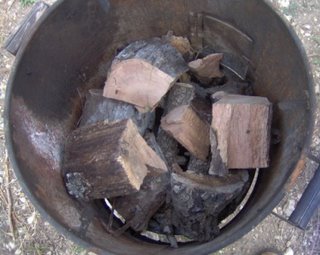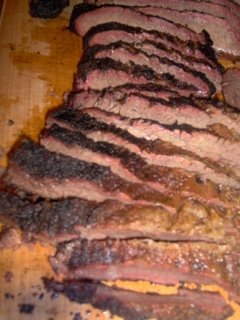I started with a dry rub of seasoned salt. I prefer beef fajita seasoning (because my best friend's dad is a bigwig with Adam's seasonings in San Antonio), but I had the seasoned salt handy. It sat like this in the fridge overnight. Here's how the guest of honor looked when ready to cook (it's folded over on itself so it will fit into the pan, and not drip all over the fridge):

Once that was done, I had to prepare the fire. I like oak wood, because when we moved in to our house, we had three or four dead oak trees on the ground, so it's free. It also makes nice hot coals, doesn't smoke too much, and cooks good meat. So here's the wood, ready to burn:

Here it is, burning. As Beavis would say, "Fire! Fire! Yeah, yeah, Fire! Heh heh heheheh....fire!"

The meat on the fire:

Notice that the fire has burned down to coals, and it isn't smoking any more. Then, I cover it up, and let R2-D2 sit all day:

R2 is a water smoker; that means that there's a pan of water between the coals and the meat. I don't think it makes the meat any more moist (cooking meat to 200 degrees, and holding it there pretty well kills the moisture), but it does serve as a buffer between the meat and the direct heat of the coals. It keeps the meat from scorching on the bottom, catches the fat drips so you don't get flare-ups, and I think the steam might help cook the meat faster.
But faster isn't what we're after here. The meat cooked for about six hours, until it looked like this:

Then I wrapped it tight in the foil, and put it in a 225 degree oven for a couple more hours. Wrapping the meat in foil traps the moisture that is steaming off the meat, and helps it cook.
Brisket is a very tough meat; it is packed with a protein called collagen, that links the muscle fibers together. However, collagen melts at 200 degrees. The long cooking time at low heat gives the collagen plenty of time to melt. This does two things. First, it unlinks the muscle fibers, so that they fall apart more easily. Second, it serves as a lubricant, so the meat doesn't feel dry in your mouth when you chew it.
After the oven time, I let the meat sit (still wrapped in foil) for about an hour. This gives a little more time for the collagen to melt, and it makes the meat easier to handle when it's cut. Here's the final result:

This brisket turned out well. It has a nice pink smoke ring, a good flavor--salty and smoky, but not too strong. And it's fork tender--no knife needed. And it only took about eleven hours. Yum!

No comments:
Post a Comment